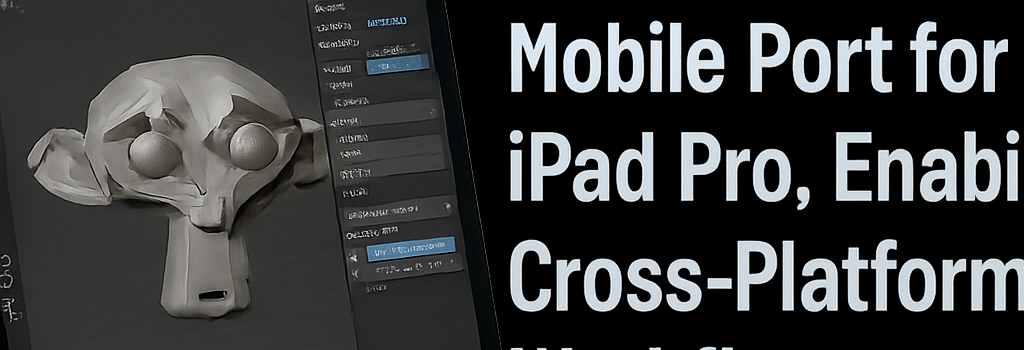Blender Begins Mobile Port for iPad Pro, Enabling Cross-Platform Workflows

After years of community requests for a tablet-optimized version of the popular open source 3D creation suite, the Blender Foundation has officially launched development of a fully featured mobile port targeting the iPad Pro. The initiative, announced in a recent blog post by Dalai Felinto, aims to deliver the full compute and authoring power of Blender on Apple’s M-series silicon, with touch-first UI paradigms and deep integration of Apple Pencil gestures.
Background: Why Tablet Matters for 3D Artists
Blender is traditionally distributed as a desktop application running on Windows, macOS, and Linux with support for OpenGL and Vulkan backends. However, as tablets like the iPad Pro and Surface Pro become increasingly capable—boasting multi-core ARM CPUs, integrated GPUs with dozens of execution units, and hardware-accelerated ray tracing—artists expect professional-grade 3D tools on mobile form factors.
Community polls on Blender’s Reddit, social media channels, and developer forums have long shown that a touch-optimized interface, paired with low-latency stylus input, could unlock new workflows in concept art, sculpting, and on-location previsualization.
“The idea is to bring the full power of Blender to these devices,” the blog post explains. “This requires adapting to platform-specific paradigms, but also to offer more task-oriented user interfaces with reduced information density.”
Technical Roadmap and Platform-Specific Adaptations
The mobile port will be developed in a separate branch built on top of Blender’s main C/C++ codebase. Key components of the technical plan include:
- Graphics Backend: Leveraging Apple’s Metal 3 API via a MoltenVK compatibility layer to translate existing Vulkan render paths for accelerated viewport performance.
- Input System: Extending Blender’s existing event model to handle touch events, multi-finger gestures, and high-precision pressure/tilt data from Apple Pencil.
- File Integration: Native support for iCloud Drive, FileProvider API, and AirDrop-based asset exchange to maintain a seamless asset pipeline.
- UI/UX: Task-oriented workspaces and application templates rendered with SwiftUI wrappers, reducing information density and improving discoverability on small screens.
- OpenSubdiv & Geometry Nodes: Cross-compilation of Pixar’s OpenSubdiv library and runtime acceleration via Metal Performance Shaders to ensure smooth subdivision and procedural modeling.
Performance Optimization on ARM-Based Tablets
Early benchmarking on the M2-powered iPad Pro indicates viewport frame rates exceeding 60 fps for scenes with up to 500,000 polygons. Developers are investigating:
- SIMD Vectorization: Rewriting critical math kernels using ARM NEON intrinsics.
- GPU Culling: Offloading view frustum and occlusion culling to compute shaders in Metal.
- Async IO: Non-blocking asset streaming via Grand Central Dispatch to keep the UI responsive during heavy file operations.
Cross-Platform Workflow Integration
Features designed for the mobile port will cross-pollinate back into the desktop builds. Planned enhancements include:
- Iconified sidebar tabs for quicker workspace switching.
- Configurable helper overlays with curated keyboard and touch shortcuts.
- Unified workspace definitions stored in JSON for both desktop and mobile templates.
Community Contributions and Expert Opinions
Blender’s core team is actively seeking collaborators with expertise in:
- Touch and gesture recognizers on iOS/macOS.
- Cross-compilation toolchains (clang/LLVM) and continuous integration for ARM targets.
- GPU programming with Metal and Vulkan.
Blender contributor and graphics engineer Marina Kirsanova notes: “We’re setting up performance tests on real hardware, and invite mobile dev experts to help optimize memory bandwidth and thread scheduling on multi-core tablets.”
Future Prospects and Next Steps
A live tech demo is slated for SIGGRAPH 2025 in Vancouver next month, showcasing sculpting, UV unwrapping, and shading within a fully touch-enabled Blender environment. Beyond the iPad Pro, developers plan to target Android tablets (leveraging Vulkan and AHardwareBuffer) and Windows 11 Surface devices using DirectX 12.
Ultimately, the goal is a seamless experience: whether you attach a keyboard and trackpad to your tablet or plug a graphics tablet into your desktop, Blender’s UI and performance will adapt, bridging the gap between mobile flexibility and desktop power.